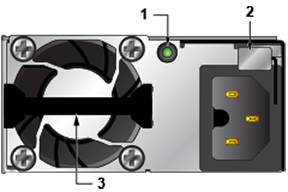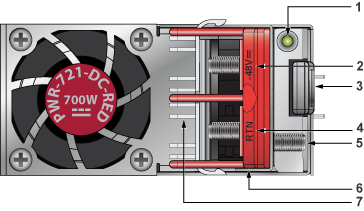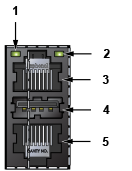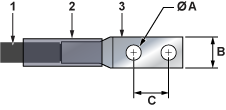Cabling the Switch
Grounding the Switch
After mounting the switch into the rack, connect the switch to the data center ground. Figure 1 display the location of the grounding pads located on the left of the rear panel.
Grounding wires and grounding lugs (M4 x 0.7) are not supplied. Wire size should meet local and national installation requirements. Commercially available 6 AWG wire is recommended for installations in the US.
À la terre et de mise à la terre fils cosses (M4 x 0.7) ne sont pas fournis. Calibre des fils doit satisfaire des exigences de l’installation locale et nationale. Disponible dans le commerce 6 fils AWG est recommandé pour les installations aux États-Unis.

| 1 | Ground | 5 | Power supply 1 status LED | 9 | Fan module 3 status LED |
| 2 | Fan module 1 handle | 6 | Power supply 2 status LED | 10 | Fan module 2 status LED |
| 3 | Fan module 2 handle | 7 | Power supply 2 | 11 | Fan module 1 status LED |
| 4 | Fan module 3 handle | 8 | Power supply 1 | 12 | Ground |
Connecting Power Cables
Power cords are optional and must be ordered separately. You must select an approved power cord that is compliant with local and national electrical codes or order one from Arista for use with the device.
(Canada Only) - CCS-722XPM-48ZY8 and CCS-722XPM-48Y4 Signal Equipment High Leakage Current
- For 100-120V operation, connect each AC power supply to its dedicated branch circuit.
- For 200-240V operation, connect each AC power supply to its dedicated branch circuit AND connect the switch to earth (Refer Figure 1).
(Canada uniquement) - Courant de fuite élevé de l'équipement de signalisation CCS-722XPM-48ZY8 et CCS-722XPM-48Y4
- Pour un fonctionnement entre 100 et 120 V, raccordez chaque alimentation électrique CA à son propre circuit de dérivation dédié.
- Pour un fonctionnement entre 200 et 240 V, raccordez chaque alimentation électrique CA à son propre circuit de dérivation dédié ET reliez le commutateur à la terre (Figure 1).
Installation of this equipment must comply with local and national electrical codes. Consult with the appropriate regulatory agencies and inspection authorities to assure compliance.
Installation de cet équipement doit être conformes aux codes électriques locaux et nationaux. Si nécessaire, consulter les organismes de réglementation appropriés et des autorités de contrôle pour assurer la conformité.
The switch operates with two installed power supplies. At least one power supply must connect to a power source. Two circuits provide redundancy protection. The Rear Panel displays the location of the power supplies on the switch's rear panel.
Read all installation instructions before connecting the system to the power source.
Lire toutes les instructions d’installation avant de brancher le système à la source d’alimentation.
- Non-Redundant Configuration: Connect power to either of the two power supplies.
- Redundant Power Supply Configuration: Connect power to both power supplies.
-
Turn off the Switch: Remove all power cords and wires from the power supplies.
Note:This equipment must be grounded. Never defeat the ground conductor.
This unit requires overcurrent protection.
Cet équipement doit être mis à la terre. Ne jamais modifier le conducteur de terre.
Cet appareil requiert une protection contre les surintensités.
AC Power Supplies
- PWR-621-AC-RED
- PWR-621-AC-BLUE
- PWR-1021-AC-RED
Figure 2 displays an AC power supply, including the power connector (C16), on the right side of the module. The AC power supply connects to a circuit that provides the required power, as specified by Specifications.

| 1 | Power supply status LED | 2 | Release | 3 | Handle |
The power supplies have a C16 connector and require cables that comply with IEC-320.
DC Power Supplies
The following DC power supplies are supported.
PWR-721-DC-RED
Figure 3 displays a DC power supply.

| 1 | Power supply status LED | 4 | Battery return (RTN) | 7 | Plastic cover |
| 2 | -48V | 5 | Protective earth | ||
| 3 | Release | 6 | Handle |
A disconnect device must be provided as part of the installation.
Assure power is removed from DC circuits before performing any installation actions. Locate the disconnect device, circuit breakers, or fuses on DC power lines servicing the circuits. Turn off the power line circuits or remove the fuses.
Wire size must comply with local and national requirements and electrical codes. Use only copper wire.
Apply ground connection to the switch first during installation and remove last when removing power.
Un dispositif de sectionnement doit être fourni dans le cadre de l'installation.
Pouvoir assurer qu'il est retiré de circuits DC avant d'effectuer des actions d'installation . Localiser les disjoncteurs ou des fusibles sur les lignes de courant continu desservant les circuits. Coupez les circuits de lignes d'alimentation ou retirer les fusibles.
Le calibre du fil doit être conforme aux exigences locales et nationales et les codes électriques. Utiliser du fil de cuivre.
Appliquer connexion à la terre à l'interrupteur premier lors de l'installation et de supprimer la dernière alimentation lors du débranchement.
Wire and Lug Preparation
Before installing, remove power from DC circuits by turning off the power line servicing the circuits. Prepare the stranded wiring before you begin a DC power installation.
Connecting a DC Power Supply to Power Source
To connect a DC power supply to a power source:
Connecting Serial and Management Cables
The accessory kit includes the following cables:
- RJ-45 to DB-9 serial adapter cable.
- RJ-45 Ethernet cable.
Table 2 lists the pin connections of the RJ-45 to DB-9 adapter cable.
| RJ-45 | DB-9 | RJ-45 | DB-9 | |||||
|---|---|---|---|---|---|---|---|---|
| RTS | 1 | 8 | CTS | GND | 5 | 5 | GND | |
| DTR | 2 | 6 | DSR | RXD | 6 | 3 | TXD | |
| TXD | 33 | 2 | RXD | DSR | 7 | 4 | DTR | |
| GND | 4 | 5 | GND | CTS | 8 | 7 | RTS | |
Figure 5 displays management ports on the rear panel of the CCS PoE switches. The Front Panel and Rear Panel display all switches' front and rear panels, which this guide covers.

| 1 | Speed status LED | 4 | Activity status LED | 3 | Ethernet management port |
| 4 | USB port | 5 | Serial console port |
- Console (Serial) Port: Connect to a PC with the RJ-45 to DB-9 serial adapter cable. The switch uses the following default settings:
- 9600 baud
- No flow control
- 1 stop bit
- No parity bits
- 8 data bits
- Ethernet Management Port: Connect to 10/100/1000 management network with RJ-45 Ethernet cable.
- USB Port: The USB port may be used for software or configuration updates.
Excessive bending can damage interface cables, especially optical cables.
Flexion excessive peut endommager les câbles d’interface, notamment des câbles optiques.

